THE HISTORY OF THE KABAR FIGHTING KNIFE
Knives have been a key fighting weapon in every war. No matter how advanced the technology, a good knife always has a place in battle.
A special breed of knives saw extensive development during WWII. Known as the "fighting knife". While it could be employed for the uses of a regular knife, its primary goal was for hand-to-hand combat. The design, balance and materials employed varied from the run of the mill knife.
This page provides a sample of the Ka-Bar fighting knives used during WWII and beyond. This information is brought to you
courtesy of MilitaryItems.com
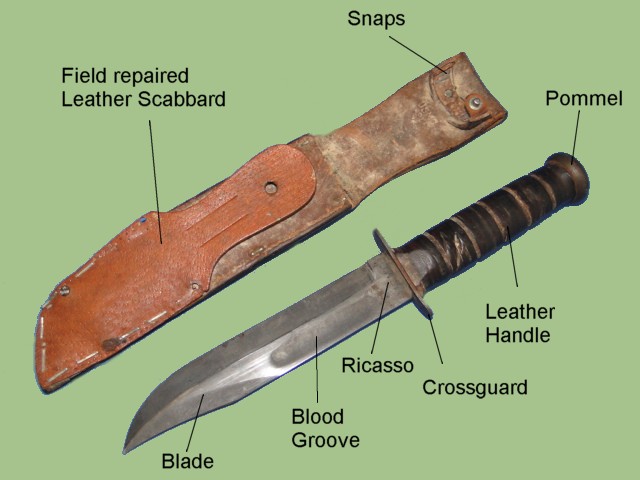
The name "KA-BAR" came to be after the company received a poorly written English letter in which the author wrote how the company's knife saved his life after he was attacked by a bear and his gun failed to kill it. All that was legible was "k a bar"—presumably fragments of the phrase "kill a bear"—and the company adopted that as their trademark. In 1942, soon after the United States' entry into World War II, American troops found that trench knives such as the
M1917/1918 or Mark I
were only suited to trench warfare and not to WWII combat.
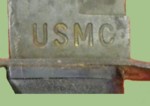 |
KA-BAR was a fighting and utility knife issued to American armed forces including the Marines and Navy. KA-BAR is also the name of a related manufacturing company most known for the same 11 3/4-inch fighting and utility Bowie knife adopted by the United States Marine Corps and United States Navy as the USN Fighting Knife Mark II.
|
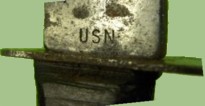 |
The Tidioute Cutlery Company was the first company to manufacture KA-BARs. The company was founded in 1898. Following its financial collapse and take-over it was renamed the Union Cutlery Company. KA-BAR was initially a trademark. In 1952 the company renamed itself KA-BAR Cutlery Inc. The headquarters are currently located in Olean, New York. The Cutco Corporation, acquired the company in 1996.
KNIFE ANATOMY
The U.S. Marines bought many different knives and designs from a large number of knife suppliers. After extensive trials under field conditions, the KA-BAR fighting knife was found to be the most popular among troops because it was adequate for most tasks demanded by a combat Marine.
The Marine Corps made several changes to the original design, these included the introduction of a small fuller to make a slightly longer but lighter blade for combat, a peened pommel (later, a pinned pommel) and a stacked leather handle for better grip. The blade, guard, and pommel were all finished in a non-reflective matte phosphate finish instead of the brightly polished steel of the original design
A typical KA-BAR knife has a 7 in. clip point blade and weighs about 1.1 lbs. The pommel consists of a metal disc which
can vary on its thickness. The handle is made of leather with channels carved at even intervals. This feature was done
as a means to improve the grip. The crossguard was a simple metal oval. Same length in each direction. The blade is
Bowie type. Very strong.
THE KA-BAR POMMEL
The characteristics of the pommel are important to note by knife collectors because they can provide clues of the age of
the knife. Here are some examples of the top of the pommel:
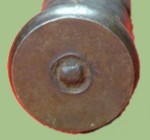 |
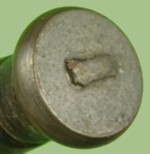 |
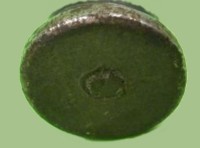 |
| Circular format with a pronounced indentation. |
Pommel top with a rectangular format. |
Pommel top shows circular dimple. No indentation. |
The top of the pommel shows how the entre knife is held together. The tang of the blade comes up to the top of the
pommel. The rest of the components (crossguard, handle) are held in place by pressure exerted by the pommel disc.
KA-BAR KNIFE MARKINGS
Millions of Ka-Bar fighting knives were made during World War II by several knife companies. The name of the manufacturer
could be placed on the blade or on the crossguard.
The following is a list of some of the factories that produced the Ka-Bar knife. It is important to note that this is not
a complete list.
| Num |
Company |
Description |
Logo |
| 1 |
the Union Cutlery Company |
This company was later renamed KA-BAR. |
 |
| 2 |
Ontario Knife Company |
|
|
| 3 |
Camillus Cutlery |
|
 |
| 4 |
Case Knives |
|
|
The inexpensive knife was easy to manufacture, and therefore easy to replace. It was also used as a diving knife in World War II though the model in use at the time disintegrated rapidly in saltwater.
After the Second World War, the U.S. military continued to use the KA-BAR. Various forms of this practical knife also
remained very popular within civilian markets, such as with hunters, fishermen, hikers, and outdoorsmen.
KA-BAR KNIFE SCABBARD
The sacabbard for the Ka-Bar knife was made of leather for the Marine Corps and fiberglass for the US Navy. The following
photos are examples of the scabbards.

The brown leather scabbard with the USMC logo and letters was used after WWII. Possibly during the Korean conflict
and definetely during the Vietnam war.

The following is a photo of the gray US navy fiberglass scabbard for the MK2 knife. This was used during
WWII.

This information is brought to you courtesy of
MilitaryItems.com
the source for military antiques and collectibles on the internet. Visit our website to see the large selection
of merchandise we have.
If you have an interest is seeing other fighting knives, you can do so by going to our
Military Fighting Knives Price Guide
identification page. Where we cover Army, Navy, Army Air Force, USMC and other military groups.
While the knives shown on this page are not for sale, you can visit our website,
MilitaryItems.com ,
to see other military and non-military knives available for sale.
|







